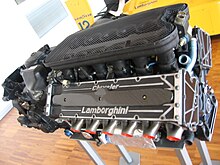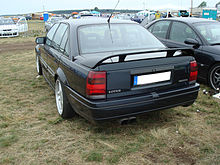Lotus 102
Lotus 102B
Lotus 102D
 |
| Category | Formula One |
|---|
| Constructor | Lotus |
|---|
| Designer(s) | Frank Dernie |
|---|
| Predecessor | 101 |
|---|
| Successor | 107 |
|---|
| Technical specifications |
|---|
| Chassis | Carbon fibre monocoque |
|---|
| Suspension (front) | Double wishbones, pull-rod dampers |
|---|
| Suspension (rear) | Double wishbones, push-rod dampers |
|---|
| Engine | 1990: Lamborghini 3512, 3,496 cc (213.3 cu in), mid-engine, longitudinally mounted, NA 80° V12
1991: Judd EV, 3,496 cc (213.3 cu in), mid-engine, longitudinally mounted, NA 76° V8
1992: Ford HB, 3,494 cc (213.2 cu in), mid-engine, longitudinally mounted, 75° NA V8 |
|---|
| Transmission | Lotus / Lamborghini 6 speed manual |
|---|
| Fuel | BP |
|---|
| Tyres | Goodyear |
|---|
| Competition history |
|---|
| Notable entrants | Team Lotus |
|---|
| Notable drivers |  Derek Warwick Derek Warwick
 Martin Donnelly Martin Donnelly
 Johnny Herbert Johnny Herbert
 Mika Häkkinen Mika Häkkinen
 Julian Bailey Julian Bailey
 Michael Bartels Michael Bartels |
|---|
| Debut | 1990 United States Grand Prix |
|---|
| Races | Wins | Podiums | Poles | F.Laps |
|---|
| 37 | 0 | 0 | 0 | 0 |
|
| Constructors' Championships | 0 |
|---|
| Drivers' Championships | 0 |
|---|
The Lotus 102 was a Formula One racing car designed by Lotus for use in the 1990 Formula One season. The 102 was an evolution of the Lotus 101 and would eventually go on to compete in 37 races spanning three seasons from 1990 until 1992.
Development
Using the 101 as its basis Frank Dernie incorporated the 640 bhp (477 kW; 649 PS) Lamborghini V12 engine that had been used by the Larrousse Lola team during 1989. Its use made the 102 the only Lotus to race with a V12 engine. The engine had several drawbacks, principally its size, weight and fuel economy. However, it was believed that the increases in power would offset these drawbacks. The engine's size meant it had to be located lower in the chassis, which also had to be designed to its widest permitted dimensions in order to incorporate larger fuel tanks. Furthermore, due to the engine's mass every component on the car had to be scrutinised to investigate whether any further weight reductions could be made elsewhere.
The departure of Nelson Piquet to Benetton and Satoru Nakajima to Tyrrell at the end of 1989 brought in the experienced Derek Warwick, and promoted test driver Martin Donnelly to fill the other vacant drivers seat. The inclusion of these drivers, who were taller than Piquet and Nakajima, incurred another design compromise as the car had to be taller than was desired.

The Lamborghini 3512 V12 engine as used in the Lotus 102 in 1990
Team Lotus's manager Rupert Mainwarring confidently predicted that the team would score 40 championship points. By the first round of the championship it was apparent that this confidence was sadly misplaced.
Racing history
1990
Team Lotus were to struggle throughout the season to score three points, its lowest score since 1958. Warwick scored all three points with a 6th place in Canada and a 5th-place finish in Hungary, while Donnelly failed to score at all. More often than not, it was the unreliability of the Lamborghini 3512 engine which cost Lotus in 1990. Ultimately this performance was to witness the departure of the lucrative Camel sponsorship the team had enjoyed since 1987 and almost cost the team its existence. Ironically, the planned use of the Lamborghini V12 was also the major reason why triple World Champion Nelson Piquet chose not to re-sign with the team after 1989 with the Brazilian correctly predicting that the under-developed engine would hamper both his and the team's chances. While the Lamborghini, one of only two V12 engines in Formula One at the time (the other being Ferrari), had shown promise with the Larrousse team in its debut season 1989, it still lagged behind the V12 Ferrari, the V10 engines from Honda and Renault, and even the Cosworth built and developed Ford V8 engine in both power and more importantly reliability.
The 102 ultimately saw the end of Martin Donnelly's brief F1 career in a crash which almost cost him his life. During the 1990 Spanish Grand Prix at Jerez, Donnelly had a horrific crash during Friday practice when he left the circuit in the fast right hand turn behind the pits and the car hit the barriers at speed. The 102 broke in half and the seat of the car broke free and was flung clear of the wreck with Martin still strapped in. Donnelly, who ended up laying in the middle of the track, received serious injuries that took months of recovery. Two races previous in Italy, Warwick also had a monumental crash on the first lap of the race at Monza when he ran wide on the exit to the Parabolica and clouted the barriers at speed. Despite the car overturning and sliding down the middle of the circuit upside down, Warwick was thankfully unharmed. He climbed out of his car, which thankfully was avoided by following cars, ran back to the pits (where he told the team and reporters that the crash was his own fault for running too wide at the Parabolica) and started the race in the spare car.
After Donnelly's career ending crash at Jerez, he was replaced for the final two races in Japan and Australia by British driver Johnny Herbert.
In December 1990, Peter Collins and Peter Wright headed a consortium which bought the team. Due to the eleventh hour nature of the takeover the team were unable to start the season with sufficient sponsorship. In addition, the planned introduction of Dernie's type 103 was shelved, the team instead opting to refresh the 102 to B standards.
In a 2014 interview when talking about his time at Lotus and with the Lamborghini engine, Derek Warwick said that the car was poor and that it would "flex all over the place, it would break, it was unreliable" before adding that the V12 engine was "all noise and no go".
1991
The Lotus 102B was Team Lotus's entry to the 1991 season. Despite having over 800 new components incorporated the new car was not sufficiently different from the 102 to justify a new type designation. This continued the precedent set by Lotus 30 years previously, whereby the Type 25 was almost completely redesigned, but was still designated the 25B.
The heavy and ultimately unreliable (in Lotus usage at least; the Larrouse-Lola outfit found better results having used the engine since 1989) Lamborghini engine was replaced by the Judd EV V8 and the driver line-up was also changed. Mika Häkkinen and Julian Bailey filled the seats vacated by a frustrated Derek Warwick and injured Martin Donnelly. It was apparent that the car was nowhere near the pace setters of the McLaren MP4/6 and the Williams FW14 at the opening round in Phoenix. Häkkinen would go on to describe that during this race his steering wheel actually came off. Bailey's failure to qualify for the Monaco Grand Prix prompted his departure and replacement with test driver Johnny Herbert for the remainder of the season. Due to Herbert's International Formula 3000 commitments the German driver Michael Bartels raced in his absence but failed to qualify.
The 102B enabled the team to equal their 1990 points total of three points. With increased sponsorship and the delay of the 107 it was to continue racing for the first four races of the 1992 season in D specification. The C specification incorporated an Isuzu P799WE (Japanese edition) V12 engine that had been developed throughout the season but never raced.
1992
The final incarnation of the 102, was the makeshift 102D that represented Team Lotus's for the start of the 1992 season. Outwardly similar to the 102B, the car had a Cosworth HB V8 in place of the Judd EV V8. In an attempt to gain exposure a 102D driven by Johnny Herbert broke the Brands Hatch Indy circuit record for the BBC Record Breakers programme.













![Validate my RSS feed [Valid RSS]](valid-rss-rogers.png)














































































